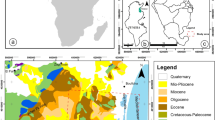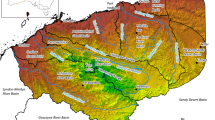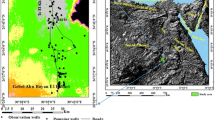Abstract
The present study is conducted in the Upper Mille River catchment of the Lower Awash Basin in Ethiopia. The main aim of the study is to investigate the groundwater potential of a complex fractured volcanic and unconsolidated Quaternary sediment aquifer system using integrated hydrogeological approaches. To estimate the hydrological components of the catchment, the soil water balance (SWB) method and Soil and Water Assessment Tool (SWAT) modeling techniques are employed. The SWB method and the SWAT model indicate that the long-term average annual groundwater recharge of the catchment is 105 mm and 150 mm, respectively, which accounts for 9.3% and 13.8% of the mean annual precipitation. Conventional hydrogeological investigation techniques are used to evaluate the spatial variability and flow dynamics of the groundwater system, as well as the various natures of the aquifers. Based on aquifer productivity, hydraulic conductivity, transmissivity, and discharge values, the aquifer system is classified into three different hydrogeological units: a highly productive intergranular aquifer, a medium productive fractured aquifer, and a low-productive aquifer. Lithological logs of deep boreholes, pumping test results, stratigraphic settings, water balance components, and the topographic position of each unit are also used to classify the aquifers. Schematic hydrogeological cross-sections, total dissolved solid (TDS) and electrical conductivity (EC) distribution maps, and groundwater head distribution contour maps are produced using lithological logs of drilled deep boreholes, field-measured inventory water points, and water level measurements, respectively. Based on converging evidence from geological, hydrogeological, and topographic settings, a conceptual model that approximates the groundwater system of the Upper Mille River catchment is developed, and the groundwater potential of the catchment is evaluated.
















Similar content being viewed by others
Data Availability
Data will be made available on request from the corresponding author.
References
Abebe B, Acocella V, Korme T, Ayalew D (2007) Quaternary faulting and volcanism in the Main Ethiopian Rift. J Afr Earth Sci 48(2–3):115–124. https://doi.org/10.1016/j.jafrearsci.2006.10.005
Abraha T, Tibebu A, Ephrem G (2022) Rapid urbanization and the growing water risk challenges in Ethiopia: the need for water sensitive thinking. Front Water 4:890229. https://doi.org/10.3389/frwa.2022.890229
Anderson MP, Woessener W (1992) Applied groundwater modeling — simulation of flow and advective transport. J Hydrol 140:1–4. https://doi.org/10.1016/0022-1694(92)90251
Arnold JG, Moriasi DN, Gassman PW, Abbaspour KC, White MJ, Srinivasan R, Santhi C, Harmel RD, Van Griensven A, Van Liew MW, Kannan N, Jha MK (2012) SWAT: Model use, calibration, and validation. Trans ASABE 55(4):1491–508
Ayenew T, Demlie M, Wohnlich S (2008) Hydrogeological framework and occurrence of groundwater in the Ethiopian aquifers. J Afr Earth Sci 52(3):97–113
Demlie M (2002) Hydrology, hydrogeology and hydrochemistry of the lakes system Hayq-Ardibo, Northern Ethiopia. Unpublished MSc thesis, Addis Ababa University, Addis Ababa, Ethiopia
Fetter CW (2001) Applied hydrogeology. Fourth Edition. Pearson New International Edition 598
Feyisa D (2018) Petrologic and Geochemical evidence for diversity of magma compositions at the Ethiopian volcanic province: implications for thermo-chemical plume influence. PhD Thesis, Okayama University, p 259
Geological survey of Ethiopia (GSE) (2015) Regional hydrogeological, hydro geophysical, hydrogeochemical and isotope hydrology of Chifra- Eliwuha area, Afar, Ethiopia. Unpublished technical report, GSE, Addis Ababa, Ethiopia, p 102
Gorelick SM, Zheng C (2015) Global change and the groundwater management challenge, Water Resour. Res. 51:3031–3051. https://doi.org/10.1002/2014WR016825
Hagos M, Konka B, Ahmed J (2016) A preliminary geological and generalized stratigraphy of western margin of northern afar. Momona Ethiop J Sci 8(1):1–22
Kebede S (2012) Groundwater in Ethiopia: features, numbers and opportunities. Springer Science & Business Media
Kebede S, Travi Y, Asrat A, Alemayehu T, Ayenew T, Tessema Z (2008) Groundwater origin and flow along selected transects in Ethiopian rift volcanic aquifers. Hydrogeol J 16(1):55–73. https://doi.org/10.1007/s10040-007-0210-0
Leap DI (1999) Geological occurrence of groundwater. In Delleur J. The Handbook of Groundwater Engineering, CRC Press LLC, pp 17–69
Megersa T, Nedaw D, Argaw M (2019) Combined effect of land use/cover types and slope gradient in sediment and nutrient losses in Chancho and Sorga sub watersheds East Wollega Zone Oromia Ethiopia. Environ Syst Res 8(1). https://doi.org/10.1186/s40068-019-0151-3
Mengistu HA, Demlie MB, Abiye TA (2019) Review: groundwater resource potential and status of groundwater resource development in Ethiopia. Hydrogeol J 27:1051–1065
Mohr P, Zanettin B (1988) The Ethiopian flood basalt province. Continental Flood Basalts 63–110. https://doi.org/10.1007/978-94-015-7805-9_3
Ponce VM, Hawkins RH (1996) Runoff curve number: has it reached maturity? J Hydrol Eng 1(1):11–19
Sahele M (2001) Hydrogeological investigation of the upper and middle Borkena river catchment, northern Ethiopia, wollo., unpublished MSc Thesis. Addis Ababa University, Addis Ababa, Ethiopia
Sima J (2017) Hydrogeological and hydrochemical maps of Dessie NC 37-3 Map Sheet. Geological Survey of Ethiopia, Addis Ababa, Ethiopia
Sophocleous MA (1991) Combining the soilwater balance and water-level fluctuation methods to estimate natural groundwater recharge: practical aspects. J Hydrol 124(3-4):229–241
Thornthwaite CW (1948) An approach toward a rational classification of climate. Geogr Rev 38:55–94
Water works design and supervision enterprise (WWDSE) (2011) Evaluation of the groundwater resources of the Teru area Groundwater basin. Unpublished technical report, WWDSE, Addis Ababa, Ethiopia, p 89
Williams FM (2016) Understanding Ethiopia. Springer International Publishing, Australia, Wolfgang Eder AV. https://doi.org/10.1007/978-3-319-02180-5
Yitbarek Baye A (2009) A hydrogeological and hydrochemical framework of complex volcanic system in the Upper Awash River basin, Central Ethiopia : with special emphasis on inter-basins groundwater transfer between the Blue Nile and Awash. Ph.D. Thesis, December, 185
Zwaan F, Corti G, Sani F, Keir D, Muluneh AA, Illsley-Kemp F, Papini M (2020) Structural analysis of the Western Afar Margin, East Africa: evidence for multiphase rotational rifting. Tectonics 39(7):1–25. https://doi.org/10.1029/2019TC006043
Acknowledgements
We greatly appreciate the National Meteorology Agency of Ethiopia, Amhara Water Works Construction Enterprise (AWWCE), and Woreda Water Bureaus for providing the necessary data for this study.
Funding
This research work is partially funded by Addis Ababa University and self-sponsored by the authors.
Author information
Authors and Affiliations
Corresponding author
Ethics declarations
We, the authors, declare and confirm that this work is our own original work and is part of the MSc thesis of the principal author. We have followed all ethical and technical research principles in the preparation, data collection, data analysis, and compilation of the research.
Conflict of interest
The authors declare that they have no competing interests.
Additional information
Responsible Editor: Amjad Kallel
Rights and permissions
Springer Nature or its licensor (e.g. a society or other partner) holds exclusive rights to this article under a publishing agreement with the author(s) or other rightsholder(s); author self-archiving of the accepted manuscript version of this article is solely governed by the terms of such publishing agreement and applicable law.
About this article
Cite this article
Gigar, A.G., Nedaw, D. & Sisay, B.M. Aquifer characterization and groundwater budget estimation of the Upper Mille River catchment, Lower Awash Basin, Ethiopia; an integrated approach for groundwater potential evaluation. Arab J Geosci 17, 96 (2024). https://doi.org/10.1007/s12517-024-11886-8
Received:
Accepted:
Published:
DOI: https://doi.org/10.1007/s12517-024-11886-8




